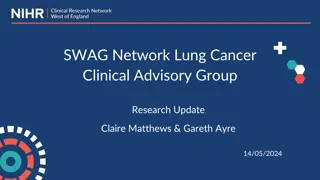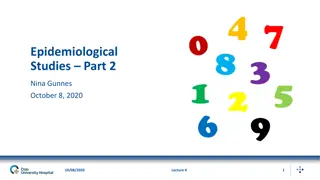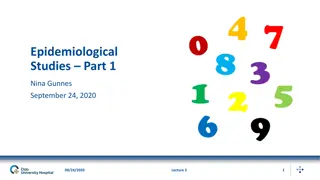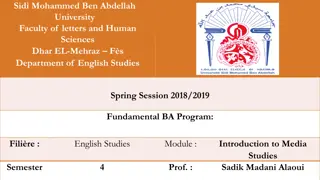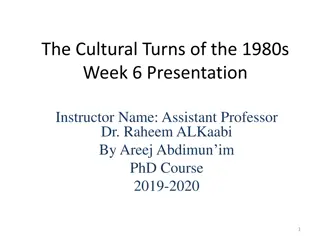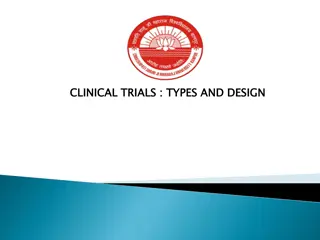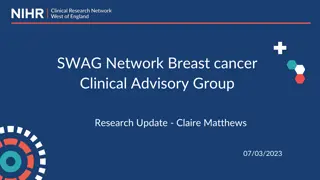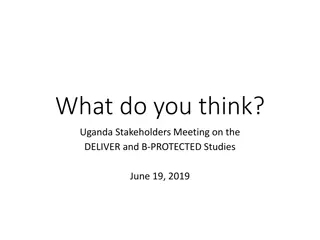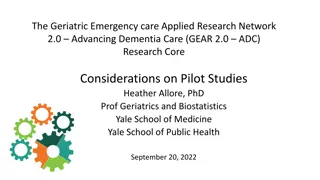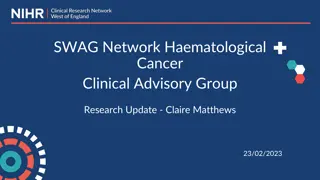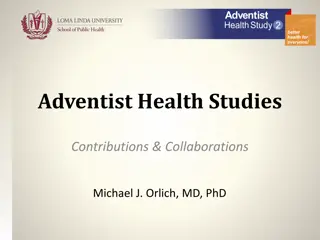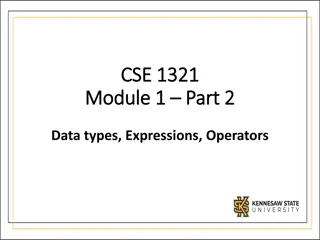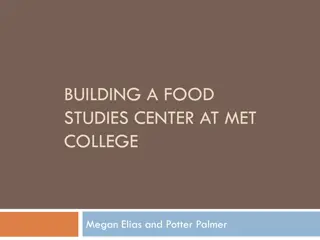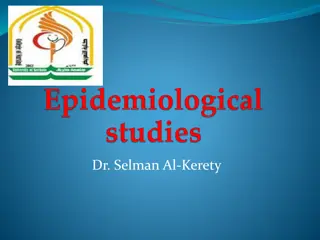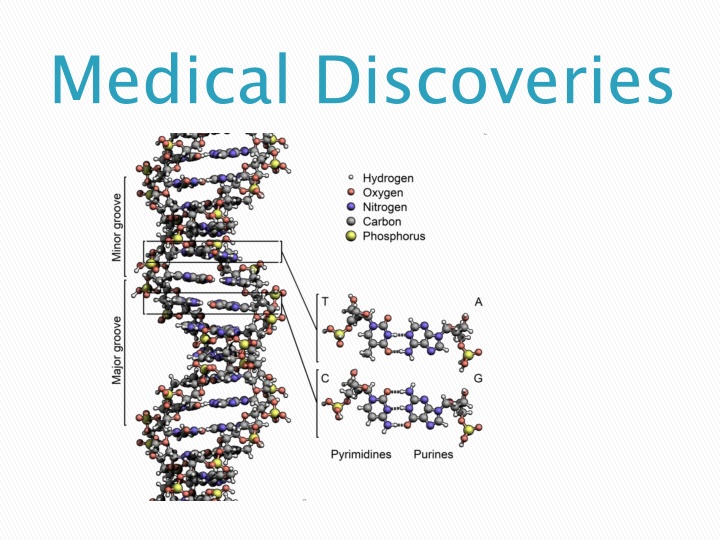
Evolution of Medical Discoveries Through History
Explore a timeline of significant medical breakthroughs from ancient times to modern advancements. From Imhotep and Hippocrates to the discovery of penicillin, smallpox vaccination, HIV, and CRISPR interference, witness the progression of medicine and healthcare. Learn about the different types of medical research, clinical studies, and case reports that contribute to our understanding and treatment of various diseases. Delve into a detailed case study of a 42-year-old male electrician's vision issues following an electrical burn. Witness the journey of medical innovations that have shaped the way we diagnose and treat illnesses over centuries of human history.
Download Presentation

Please find below an Image/Link to download the presentation.
The content on the website is provided AS IS for your information and personal use only. It may not be sold, licensed, or shared on other websites without obtaining consent from the author. If you encounter any issues during the download, it is possible that the publisher has removed the file from their server.
You are allowed to download the files provided on this website for personal or commercial use, subject to the condition that they are used lawfully. All files are the property of their respective owners.
The content on the website is provided AS IS for your information and personal use only. It may not be sold, licensed, or shared on other websites without obtaining consent from the author.
E N D
Presentation Transcript
2600 BC Imhotep describes 200 illnesses 420 BC Hippocrates Oath 1249 Glasses to correct eye vision 1736 Operation of appendix 1796 Vaccination against smallpox- 1976 eradication of smallpox 1895 R ntgen 1928 Penicillin 1954 First kidney transplant 1965 Ultrasound 1971 CT 1981 Discovery of HIV 1987 Separation of conjoined twins
2000 Human Genome sequenced 2003 SARS 2006 HPV vaccine 2007 Stem cells created from skin cells 2012 HIV Pre-exposure prophylaxis 2013 First created kidney transplanted in mice 2015 CRISPR interference
describe new things determine causes of diseases determine which medication/procedure is better
Original research article new knowledge for the first time
Clinical observation Case report Case series Observational studies Cross-sectional Case-control Cohort Experimental studies (Randomized) controlled clinical trial N of 1 trial Qualitative studies
detailed report of the symptoms, signs, diagnosis, treatment, or a follow-up of an individual patient. anecdotal evidence lack of generalizability CARE (i.e. CAse REport) guidelines Include patient s perspective and informed consent
A 42-year-old male electrician presented to the eye clinic with decreasing vision 4 weeks after an electrical burn of 14,000 V to the left shoulder. His vision in both eyes was limited to perception of hand motions, with an intraocular pressure of 14 mm Hg in each eye. Slit-lamp examination showed bilateral stellate anterior subcapsular opacities of the lens.
Four months after the injury, the patient underwent cataract extraction and implantation of an intraocular lens, which was followed by improvement in visual acuity to 20/70 in the right eye and 20/400 in the left eye. Two years after the injury, a retinal detachment developed in the left eye, and the patient underwent repair. At a 10-year follow-up visit, the patient's visual acuity was 20/100 in the right eye, but in the left eye he could only count fingers Although the patient was legally blind, he was able to read with the use of low-vision aids and was able to independently commute on public transportation. When lenticular opacities are the sole manifestations of electrical injury, cataract extraction is expected to produce a functional outcome. However, with concurrent damage to the optic nerve and retina, complete visual rehabilitation may be limited.
A strike of lightning left Winston Kemp, a 24-year- old electrician, with a skin discoloration. Known as a "Lichtenberg figure," for the German physicist who first described seeing a similar pattern while experimenting with static electricity, these reddish fern-leaf patterns are a skin reaction to a lightning strike. They are sometimes referred to as "lightning flowers" or "lightning trees." and tend to occur on the arms, back, neck, chest, or shoulders of lightning strike victims.
number of subjects with a known exposure, treatment, or outcome informed consent and patients perspective should also be included statistical procedures justified
In the period October 1980-May 1981, 5 young men were treated for biopsy-confirmed Pneumocystis carinii pneumonia at 3 different hospitals in Los Angeles, California. Two of the patients died. All 5 patients had laboratory-confirmed previous or current cytomegalovirus (CMV) infection and candidal mucosal infection. The patients did not know each other and had no known common contacts or knowledge of sexual partners who had had similar illnesses. Two of the 5 reported having frequent homosexual contacts with various partners. All 5 reported using inhalant drugs, and 1 reported parenteral drug abuse. Patients had profoundly depressed in vitro proliferative responses to mitogens and antigens.
Pneumocystis pneumonia in the United States is almost exclusively limited to severely immunosuppressed patients (1). The occurrence of pneumocystosis in these 5 previously healthy individuals without a clinically apparent underlying immunodeficiency is unusual. The fact that these patients were homosexuals suggests an association between some aspect of a homosexual lifestyle or disease acquired through sexual contact and Pneumocystis pneumonia in this population. It also suggests the possibility of a cellular-immune dysfunction related to a common exposure that predisposes individuals to opportunistic infections such as pneumocystosis and candidiasis.
a snapshot of a population (sample) survey conducted at one point in time determines prevalence - % of characteristic (disease) found association not casuation Reporting guidelines STROBE (Strengthening the Reporting of Observational Studies in Epidemiology)
Students at the Karolinska Institute Medical University, Stockholm, Sweden were asked to complete a Higher Education Stress Inventory (HESI) and the Major Depression Inventory (MDI). The prevalence of depressive symptoms among students was 12.9%, significantly higher than in the general population, and was 16.1% among female students versus 8.1% among males. A total of 2.7% of students had made suicide attempts, but none during the previous year. A gender difference regarding stress levels was also seen, where women reported higher levels of stress than men.
identify factors that may contribute to a medical condition by comparing subjects who have that condition/disease (the "cases") with patients who do not have the condition/disease but are otherwise similar (the "controls") rare diseases hard to find large samples odds ratio - how strongly the presence or absence of a factor is associated with the disease
vrijeme exposed exposed not-exsposed past not-exposed Healthy Measurem ent - now Disease controls (controls) cases (cases)
B: Pancreatic neuroendocrine tumors (PNETs) are uncommon, and little is known about their risk factors and association with other cancers. We evaluated whether the following risk factors known to be associated with pancreatic adenocarcinoma are also associated with PNETs: smoking, alcohol use, family history of PNET, other cancers, and personal history of diabetes. M: Patients with PNETs seen at Mayo Clinic Rochester between 2000 and 2011 were compared with controls seen for a general medical evaluation. Patients and controls completed the same questionnaires, 309 patients were matched to 602 controls (2:1) on age, sex, and region of residence.
RESULTS: Personal smoking history was not associated with PNETs. Alcohol use was less common among cases (54% vs 67%, P < 0.001). Cases were more likely to report a family member with sarcoma (P = 0.02), PNET (P = 0.02), gallbladder cancer (P = 0.02), ovarian cancer (P = 0.04), and gastric cancer (P = 0.01). There was no association with other cancers in family members. Diabetes was more commonly reported by cases than controls (19% vs 11%, P < 0.001). CONCLUSIONS: With the exception of diabetes, risk factors that are associated with pancreatic adenocarcinoma are not risk factors for PNETs. RESULTS: CONCLUSIONS:
cohort Does a certain factor increase the likelihood of a disease? Step 1 (without the disease Step 2 cohort basic tactical unit of a Roman legion (480 soldiers) Step 1 - form a cohort individuals without without a certain characteristic without the disease) Step 2 - form two groups 1) exposed to a factor and 2) non-exposed Step 3 Step 3 follow them over time (months, years, decades) Incidence can determine causality Relative risk exposed group to the probability of the event occurring in the non- exposed group Cohort studies are used to determine the causes of disease and to follow effectiveness of treatment Incidence (a number of new cases during a time period, usually a year) Relative risk: ratio of the probability of an event occurring in an
The researchers in 1948 recruited 5,209 men and women between the ages of 30 and 62 from the town of Framingham, Massachusetts, and began the first round of extensive physical examinations and lifestyle interviews that they would later analyze for common patterns related to cardio vascular diseases for the next 30 years. 1961 Cholesterol level, blood pressure, and electrocardiogram abnormalities found to increase the risk of heart disease 1967 Physical activity found to reduce the risk of heart disease and obesity to increase the risk of heart disease 1988 High levels of HDL cholesterol found to reduce risk of death 1999 Lifetime risk at age 40 years of developing coronary heart disease is one in two for men and one in three for women 2002 Lifetime risk of developing high blood pressure in middle- aged adults is 9 in 10. 2005 Lifetime risk of becoming overweight exceeds 70 percent, that for obesity approximates 1 in 2
In the present - researchers pick a cohort from the past (e.g. those born in 1960, or those living in a certain city, working at a specific factory) and collect data from existing medical records They are also divided into two groups exposed and non-exposed The time to complete a retrospective study is only as long as it takes to collect and interpret the data.
Retrospective cohort study was conducted in 233 benzene factories and 83 control factories in 12 cities in China in 1982. The benzene cohort and the control cohort consisted of 28,460 benzene exposed workers and 28,257 control workers. Medical records were checked from 1972. Thirty cases of leukaemia (25 dead and 5 alive) were detected in the former and four cases (all dead) in the latter. Most (76.6%) cases of benzene leukaemia were of the acute type. The mortality due to benzene leukaemia was high in organic synthesis plants followed by painting and rubber synthesis industries.). Of the 25 cases of leukaemia, seven had a histThe concentration of benzene to which patients with a leukaemia were exposed ranged from 10 to 1000 mg/m3 (mostly from 50 to 500 mg/m3ory of chronic benzene poisoning before the leukaemia developed. The relative risk of leukaemia for the benzene workers was 6.97.
Time of study group formation Time of data collection Cross-sectional study Case control study Experimental research Cohort study Historical cohort study sada njost Present pro lost budu nost Future Past
The researchers recruited 5,209 men and women between the ages of 30 and 62 from the town of Framingham, Massachusetts, and began the first round of extensive physical examinations and lifestyle interviews that they would later analyze for common patterns related to cardio vascular diseases. 1961 Cholesterol level, blood pressure, and electrocardiogram abnormalities found to increase the risk of heart disease 1967 Physical activity found to reduce the risk of heart disease and obesity to increase the risk of heart disease 1988 High levels of HDL cholesterol found to reduce risk of death 1999 Lifetime risk at age 40 years of developing coronary heart disease is one in two for men and one in three for women 2002 Lifetime risk of developing high blood pressure in middle- aged adults is 9 in 10. 2005 Lifetime risk of becoming overweight exceeds 70 percent, that for obesity approximates 1 in 2
Antibiotic streptomycin had been discovered two years previously by Waksman (Schatz, Bugie, and Waksman, 1944); in the intervening period its power of inhibiting tubercle bacilli in vitro, and the results of treatment in experimental tuberculous infection in guinea-pigs, had been reported; these results were strikingly better than those with any previous chemotherapeutic agent in tuberculosis. In 1946 no controlled trial of streptomycin in pulmonary tuberculosis had been undertaken in the U.S.A. The Committee of the Medical Research Council decided then that a part of the small supply of streptomycin allocated to it for research purposes would be best employed in a rigorously planned investigation with concurrent controls.
By September, 1947, 109 patients had been accepted, and no more were admitted to this trial. Two patients had died within the Preliminary observation week; these are excluded from the analysis. Of the remaining 107 patients 55 had been allocated to the streptomycin group and 52 to the control group. Determination of whether a patient would be treated by streptomycin and bed-rest (S case) or by bed-rest alone (C case) was made by reference to a statistical series based on random sampling numbers drawn up for each sex at each centre by Professor Bradford Hill.
Four of the 55 S patients (7%) and 14 of the 52 C patients (27%) died before the end of six months. The difference between the two series is statistically significant; the probability of it occurring by chance is less than one in a hundred. At four months after admission the general condition had improved in 40 (73%) of the 55 S patients, compared with 26 (50%) of 52 C patients.
Analysis of the results at the end of the first six-month period has shown that the course of bilateral acute progressive disease can be halted by streptomycin therapy; 51% of the streptomycin-treated patients showed considerable improvement radiologically when comparison was made with their chest radiographs taken on admission. That streptomycin was the agent responsible for this result is attested by the presence in this trial of the control group of patients, among whom considerable improvement was noted in only four (8%), and two of these four patients had improved only after collapse therapy. In other words streptomycin therapy was effecting what the patient's tissues alone could not do-checking the spread of the tubercle bacillus in one of its most favorable milieiux.
Cross- sectional study Case-control Cohort Experimental Incidence/ Prevalence prevalence - incidence incidence Outcome >1 1 >1 >1 Causality No No Yes Yes Sample (N) big/small small big small/big Duration * ** *** *** Price * ** *** ****
a single patient is the entire trial It is used to choose optimal choice of treatment (drug) for a patient (personalized medicine) random allocation can be used to determine the order in which an experimental and a control intervention are given to a patient
ABA design most common A no treatment or placebo or golden standard B experimental drug Variants: ABAB ABABAB ABBA
concerns about the carryover effects of the interventions - interventions may linger in the system after administration it is important to ensure that the treatment periods are sufficiently long (washout and crossover periods) and that statistical methods appropriately accommodate or consider carryover effects when data is analyzed
Ornithine transcarbamylase deficiency (OTCD) is an X-linked disorder of the urea cycle. It is often fatal in affected males. Treatment for affected individuals includes dietary protein restriction, activation of alternative pathways of nitrogen excretion and L-arginine supplementation. Depending on the amount of X chromosome inactivation skewing, females show variable clinical manifestations, and sometimes the need for treatment, including medications, is unclear. We conducted an n of 1 randomized controlled trial on an obligate OTC carrier. The treating physician and patient were blinded to treatment. Either placebo capsules or L-arginine capsules were given for weekly periods. Weekly efficacy indicators included plasma arginine and glutamine levels and a quality of life/mood assessment questionnaire scale. Clear evidence of benefit with L-arginine compared to placebo was shown. This is the first time an n of 1 randomized controlled trial has been reported for an X-linked metabolic condition.
in-depth understanding of a phenomena Main question is - Why? when little is known about a topic, when the research context is poorly understood, when the boundaries of the domain are ill defined, when the phenomenon is not quantifiable, when the nature of the problem is murky, or when the investigator suspects that the status quo is poorly conceived and the topic needs to be re-examined
Brief overview of qualitative research Methods: Participant observation In-depth interviews Focus groups Text/discourse analysis Why use qualitative research: New/emergent topics Lived experience Meanings and motives under the numbers Develop hypotheses for further quantitative testing ( mixed methods ) Designs: Ethnography Grounded theory Phenomenology
AIM: AIM: The aim of this study was to describe Norwegian healthcare staffs' experiences of participating in care of patients with Ebola virus disease in Sierra Leone. BACKGROUND: contagious with high mortality. DESIGN: METHOD: eight nurses and one physician who had worked in Ebola care in Sierra Leone. The interviews were analysed using qualitative content analysis. RESULT: manage risks'; and 'Developing courage and growth by facing personal fears'. Subthemes were: 'Relying on safeguard actions', 'Managing risk of contagion', 'Developing strategies for care despite risks', 'Constantly reminded of death', 'Successively defeating fears' and last, 'Increasing motivation through meaningfulness'. The participants described the reliance on training, organized effort, strict guidelines and equipment. They were respectful of the risk of transmission, made risk assessments, took responsibility, handled risky situations and were reminded of suffering and death. CONCLUSION: was experienced as meaningful which was an important motivator. Safe care was central in working with Ebola patients, but the care relation was challenged. BACKGROUND: Ebola is one of the most feared viruses known. Ebola virus disease is highly DESIGN: Descriptive study with qualitative approach. METHOD: Individual narrative and focus group interviews were obtained during 2015 with RESULT: The analysis resulted in the two themes: 'Experiencing security by learning to CONCLUSION: Despite challenges, the hazardous work with Ebola virus disease patients
Systematic reviews with/without a meta- analysis Systematic review current literature relevant to a research question (very detailed search strategy) Systematic review - exhaustive review of Meta large collection of analysis results from individual studies for the purpose of integrating the findings Meta- -analysis analysis is the statistical analysis of a
BACKGROUND: lead to potentially fatal illness, disability and death. However, public debate over the safety of the trivalent MMR vaccine and the resultant drop in vaccination coverage in several countries persists, despite its almost universal use and accepted effectiveness. OBJECTIVES: MMR vaccine in children up to 15 years of age. SEARCH METHODS: Controlled Trials (CENTRAL) (The Cochrane Library 2011, Issue 2), which includes the Cochrane Acute Respiratory Infections Group's Specialised Register, PubMed (July 2004 to May week 2, 2011) and Embase.com (July 2004 to May 2011). MAIN RESULTS: clinical trial (CCT), 27 cohort studies, 17 case-control studies, five time-series trials, one case cross-over trial, two ecological studies, six self controlled case series studies involving in all about 14,700,000 children and assessing effectiveness and safety of MMR vaccine. Based on the available evidence, one MMR vaccine dose is at least 95% effective in preventing clinical measles and 92% effective in preventing secondary cases among household contacts. Exposure to the MMR vaccine was unlikely to be associated with autism, asthma, leukaemia, hay fever, type 1 diabetes, gait disturbance, Crohn's disease, demyelinating diseases, bacterial or viral infections. BACKGROUND: Mumps, measles and rubella (MMR) are serious diseases that can OBJECTIVES: To assess the effectiveness and adverse effects associated with the SEARCH METHODS: For this update we searched the Cochrane Central Register of MAIN RESULTS: We included five randomised controlled trials (RCTs), one controlled
Hierarchy of evidence 1. N of 1 randomized control trial 2. Systematic reviews of randomized control trials 3. Single randomized control trial 4. Systematic review of observational (cross-sectional, cohort, or case-control) studies 5. Single observational (cross-sectional, cohort, or case-control) study 6. Physiologic studies (studies of blood pressure, cardiac output, exercise capacity, bone density, etc) 7. Unsystematic clinical observations (case series, case report)


